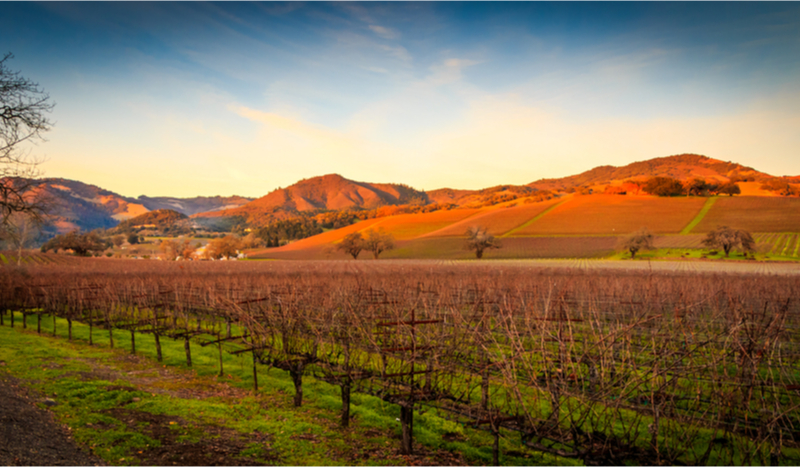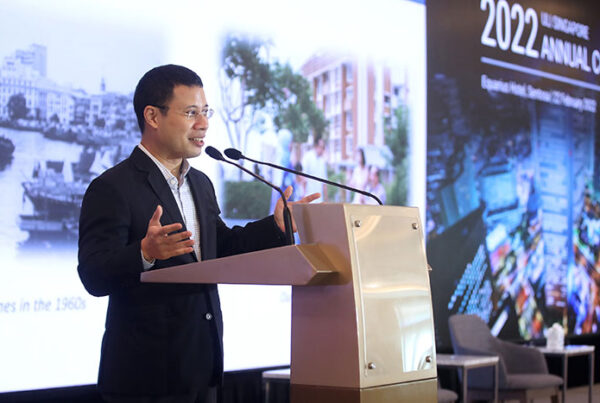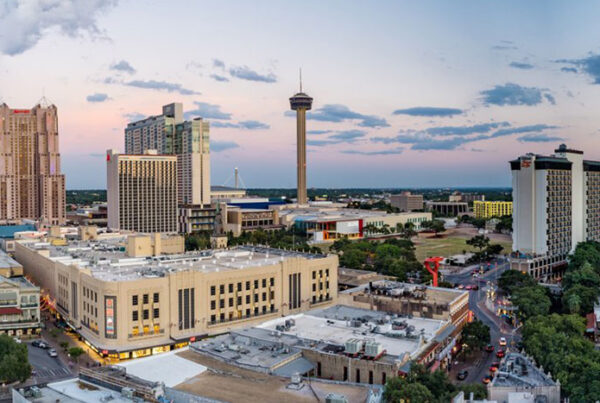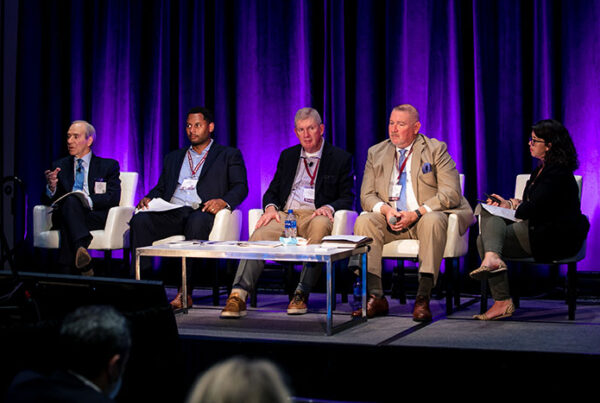
(Shutterstock)
In 2017, the Tubbs Fire burned across 36,807 acres in Sonoma and Napa counties, killing 22 people and destroying 5,636 structures, half of which were homes in Santa Rosa, Sonoma’s largest city. In 2019, the historically large Kincade Fire burned 77,758 acres in Sonoma County and destroyed 374 structures. Then in 2020, the Glass Fire burned 67,484 acres in Sonoma and Napa counties.
Such wildfires have become an all-too-regular part of life in Sonoma County, California, home to vineyards, rolling foothills, coastal forests, and about half a million full-time residents. Climate change is predicted to increase the frequency and intensity of wildfires in Sonoma and—without significant mitigation and adaptation—the risk of more destroyed homes, businesses, ecosystems, and lives will continue to rise.
Sonoma County’s Regional Climate Protection Authority (RCPA) turned to ULI’s Urban Resilience and Advisory Services programs to help create a vision for a more sustainable, equitable, economically stable, fire-resilient future for the county and its towns and cities. RCPA sponsored an ULI Advisory Services panel, with support from the Kresge Foundation and guidance from an interdepartmental Sonoma County and City of Santa Rosa Steering Committee.
In April, panelists presented recommendations for how Sonoma can get to that fire-resilient future with better land management, infill development and affordable housing, more reliable energy grids, expanded government partnerships, and much more. The panel was made up of a diverse range of volunteer experts, including panel chair Molly McCabe, CEO and founder of HaydenTanner; Jose Bodipo-Memba, director of sustainable communities, Sacramento Municipal Utility District and vice chair of ULI Sacramento; Christopher Calott, associate professor, University of California, Berkeley, Real Estate Development and Design program; Jeremy Klemic, associate principal, SWA; John Macomber, senior lecturer, Harvard Business School; Molly Mowery, executive director, Community Wildfire Planning Center; Peter Quintanilla, urban design studio leader, Michael Baker International; Diana Ramirez, director, economic development and strategic Investments, Travis County (Texas); and Neil Webb, director, Ramboll.
The panel drew on briefing materials prepared by RCPA, research, public records, and interviews with Sonoma County residents and leaders to craft its recommendations.
“The pandemic is just the latest of a series of catastrophic disasters we’ve had to face down since 2017,” said Sonoma County Board of Supervisors member Lynda Hopkins in the panel’s opening remarks. “I am proud, though, that out of this collective community trauma there’s also a tremendous sense of urgency and a willingness to take risks to create substantial change to address the climate crisis we face.”
The panel suggested that increased fire resilience for Sonoma County will come from scaling up land management programs and applying fireproofing standards to more structures. The land management goal is not to suppress every fire, but to try to reduce the severity of the fires and the resulting damages.
“We’re really starting to understand what living with fire means,” said Klemic. “I cannot stress enough how much healthy forestry practices will play a critical role in fire resiliency.”
The panel proposed a series of strategically located regional “protective corridors” with carefully managed vegetation that would slow the advancement of fires into developed areas and provide a safer, more effective firefighting environment. Klemic, whose background is in landscape architecture, said that with this strategy—along with thinning forests and replanting non-native vegetation with fire-tolerant tree species—Sonoma County can greatly reduce the risk of future megafires.
To further protect communities from wildfire, the panelists proposed extending existing bike/pedestrian trails as outer rings to towns and cities. These trails would increase residents’ quality of life, add an attraction for the visitors who make up the county’s considerable tourist economy, and let animals like cows and goats graze along the trails to keep flammable plant life at bay.
How Sonoma approaches land use and construction also is critical to mitigating wildfire risk. Some of the homes within Sonoma County are already required and are built to meet California’s longstanding Chapter 7A building code, which mandates best practices in fire-resilient home hardening. Mowery presented the panel’s recommendation that Sonoma County establish a similar minimum wildfire resilience standard for all of its built environment.
The panel commended the county and city of Santa Rosa for prioritizing infill development and recommended strategies to accelerate this approach. By building denser housing in existing cities and towns, Sonoma will slow the expansion of housing into the wildland urban interface (WUI)—the spaces where the built and natural environment intermingle and wildfires often cause massive damage. Wildfires are going to continue to happen, but the fewer developments built where they occur, the less threat they are to human safety.
Infill development also is essential for reducing Sonoma’s climate impact. Climate change and the worsening drought conditions it brings are contributing to California’s more frequent and severe wildfire seasons. Denser housing built near transit and closer to the places where people work, shop, and recreate has a far smaller environment impact than sprawling development that requires long drives.
The panel stressed that the kinds of housing Sonoma’s cities and towns build and how it is designed will also be important. As is the case just in many parts of Northern California, the cost of living in Sonoma has soared over the past decade, and its communities need more housing to meet the demand.
Recognizing that the idea of denser development often makes people nervous, Quintanilla presented medium-density developments such as two- to three-story apartment buildings with 12 to 20 units. They can be designed with flourishes like red tile roof to match the Spanish Colonial Revival style found around Sonoma County. Similarly, Calott said the panel recommends that Sonoma’s communities look to “gentle density” solutions such as duplexes, triplexes, accessory dwelling units (ADUs), and cottage compounds to increase housing options while matching the small-town feel.
Increasing the amount of affordable housing is essential. Not only will subsidized housing help meet the huge need, Ramirez said, it can help sell the story of why Sonoma’s communities need to take these steps, adding, “Affordable housing benefits the people that provide critical services in the community.”
Housing and land use are not the only elements of creating a more resilient micro-economy. Renewable energy sources will help the county mitigate its climate impact. More localized energy infrastructure also is critical for helping Sonoma residents withstand fire season. In recent years, energy company PG&E has shut off power to hundreds of thousands of residents in Northern California for days at a time during fire season as a preventative measure against sparking transmission lines starting wildfires.
Webb said Sonoma could start building microgrids that provide power closer to where it is used and invest in renewable energy sources and better energy storage. To get there, the county must focus on increasing communication about and expanding existing energy and residence programs regionally; commit to transitioning infrastructure rather than replacing in-kind; identify equitable regional wildfire prioritization metrics; and, over the long term, evaluate emerging technologies for energy independence and wildfire resilience.
Sonoma is already spending an average of $2 billion to $3 billion a year countywide on disaster recovery and rebuilding, factoring in the $10 billion spent on disaster recovery since 2017. Reshaping a county and its individual communities for increased fire resilience will not come cheaply, but Macomber made the point that the status quo is far from free.
Macomber said that by investing upfront in resilience, the county could reduce costs over time to $1.5 billion in disaster response and rebuilding costs and sustainability investments. In doing so, the county could create a “virtuous cycle” wherein communities build the housing and create the jobs to, in turn, gain economic vitality, grow the tax base, and improve the quality of life, then start the cycle anew.
Finding funding is never easy, Ramirez said, but a broad coalition could be competitive in winning federal, state, and philanthropic funding and have significant positive impact in effectively leveraging the funding via a coordinated strategy. The panel recommended formalizing intergovernmental collaboration with new mutual aid agreements and pre-positioning contracts with local nonprofit organizations to increase the county’s response and recovery efforts ahead of the 2021 fall wildfire season.
“You need champions to help you make the paradigm shifts to get beyond disaster response to prevention and equitable recovery,” Ramirez said. “It can’t just be government officials pulling the weight. You need community, philanthropic, education, business, and private sectors. By aligning planning, funding, and actions, a regional consortium often exceeds the sum of its parts.”
In many instances, the work is already underway in Sonoma County to implement versions of the panel’s ideas. After an exceptionally dry winter in Northern California, the upcoming fire season looms large, and changes to bring about a more sustainable, wildfire resistant future cannot come soon enough.
Since 1947, ULI’s Advisory Services program has provided strategic advice to communities and organizations on a wide variety of land use, real estate, planning, urban design, economic development, and public policy challenges. Learn More



